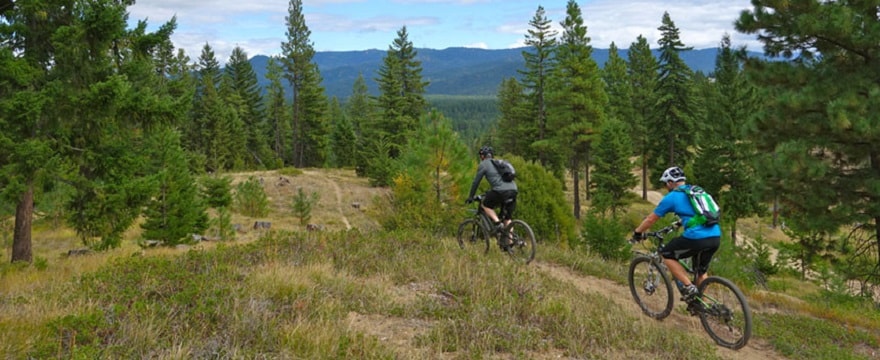Ride the Teanaway; explore its geologic story (a guest blog from DNR)
If the hills of the Teanaway could talk, they would tell tales of bubbling lava, ancient jungles roamed by coyote-sized horses, and a shoreline triggered by great blocks of melting glacial ice.
While all is quiet in the Teanaway now, the beauty that we enjoy today was formed by massive events that gave rise to one-of-a-kind geologic features. The fascinating landscape has a history of drawing people to its landscape, just a few miles east of Cle Elum. It’s a popular recreation destination for cross-country skiers, campers, ORV owners, and mountain bikers.
 When you visit the landscape you’ll witness the impressive power of erosion. Its work has exposed formations of resistant Roslyn Formation sandstone, remnants of 40 million year-old swamps and rivers that also left behind a coal field mined for more than 80 years.
When you visit the landscape you’ll witness the impressive power of erosion. Its work has exposed formations of resistant Roslyn Formation sandstone, remnants of 40 million year-old swamps and rivers that also left behind a coal field mined for more than 80 years.
Even older, a dark, blocky rock unique to this area and accordingly named Teanaway Basalt, holds up the high ridges north and west of the forest. It was formed as continental plates moved and stretched creating crack and fissures that basalt lava filled up from below.
This process also formed small cavities in the basalt that later filled with silica-rich fluid. This fluid eventually crystalized and become rare Ellensburg Blue agates. It’s the only place in the world where the Ellensburg Blue agate exists.
So, we see that these hills, or at least their rocks, do talk. The Division of Geology and Earth Resources, a part of Washington State’s Department of Natural Resources, is helping people to interpret what these stones tell us.
 A new one-page geologic map and summary centers in on the agency’s new Teanaway Community Forest and surrounding area. Print it and take it with you as you bike from one of the area’s three DNR-managed campgrounds.
A new one-page geologic map and summary centers in on the agency’s new Teanaway Community Forest and surrounding area. Print it and take it with you as you bike from one of the area’s three DNR-managed campgrounds.
Sites are first-come, first-serve and rustic, though free with the cost of a Discover Pass. From the area’s three campgrounds riders can access a variety of old roads that are open to non-motorized travel which, like the campgrounds, sit atop lower Roslyn Formation sandstone.
If you have a good map and are prepared for water crossings the area’s West Fork Teanaway and Middle Fork Teanaway trails offer challenging multi-use single track, watch for motorists and remember to yield to horses, which frequent the Indian Camp area. (Other amazing Teanaway-area rides are Stafford Creek, Miller Peak, and Esmeralda - though not technically in the TCF, they are certainly bucket-list worthy)
 All of your options begin with a climb, but you soon find yourself amid the chunky Teanaway Basalt that makes up the area’s high summits and impressive rock features. Take the map and summary to spot signs of the area’s geology or explore points of interest. You’ll leave with a greater understanding and appreciation for how the surrounding mountains and valleys were formed.
All of your options begin with a climb, but you soon find yourself amid the chunky Teanaway Basalt that makes up the area’s high summits and impressive rock features. Take the map and summary to spot signs of the area’s geology or explore points of interest. You’ll leave with a greater understanding and appreciation for how the surrounding mountains and valleys were formed.
If you go, keep in mind that trail and road conditions can be rough and signage uncertain. Until recently, the Teanaway was privately owned. It was purchase in 2013 as the state’s first community forest and is now co-managed by the Department of Natural Resources and Department of Fish and Wildlife.
A management plan, created with broad stakeholder and Evergreen Mountain Bike Alliance participation, was adopted last year to outline how the more than 50,000 acres should be cared for in the future.
When you visit, remember to bring your Discover Pass – its display on vehicles is now required at trailheads and in campgrounds. This time of year the geology, trails, and roads are covered by a blanket of snow. The 29 Pines Campground, with good proximity to winter recreation trails remains open, though it’s not plowed so access by vehicle can’t be guaranteed. Indian Camp and Teanaway Campground are expected to reopen, weather permitting, in April. Check trail reports for spring riding conditions.
The Division of Geology and Earth Resources intends to produce more one-page geologic summaries for other landscape destinations in the future. This one is available at www.dnr.wa.gov/Teanaway.

